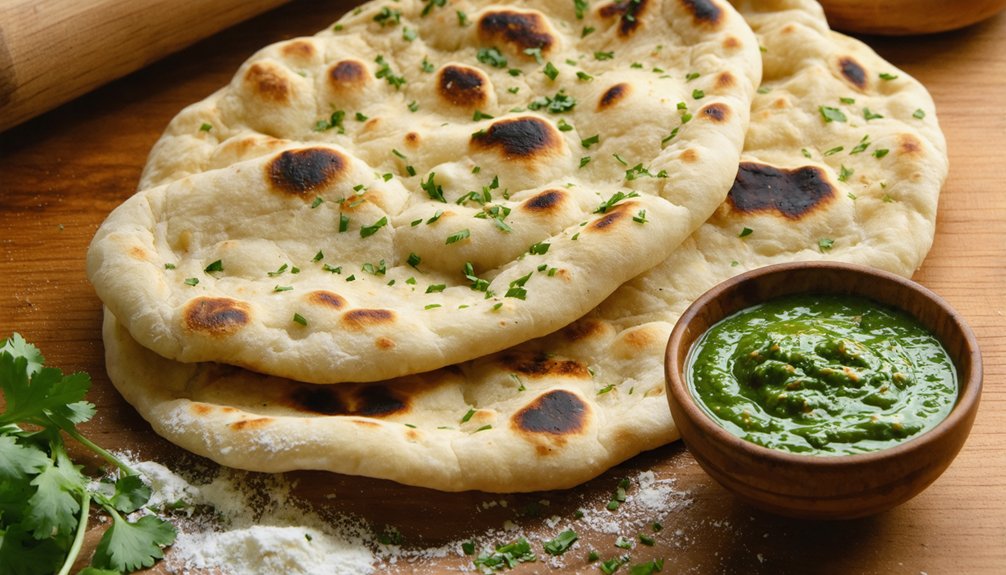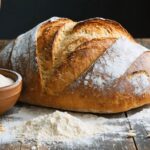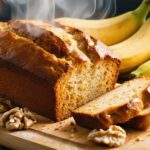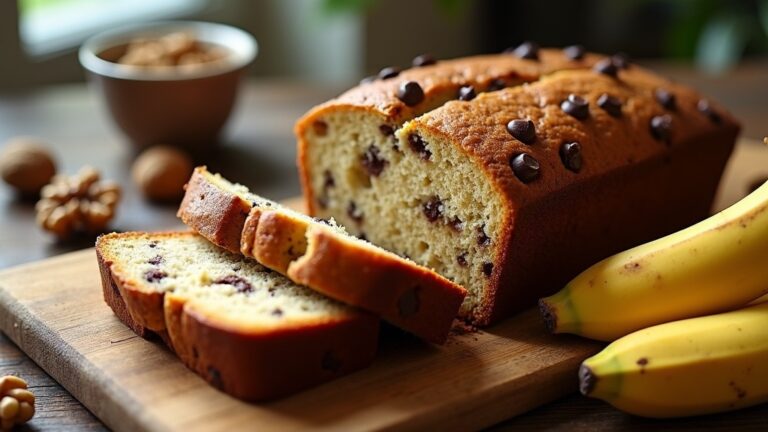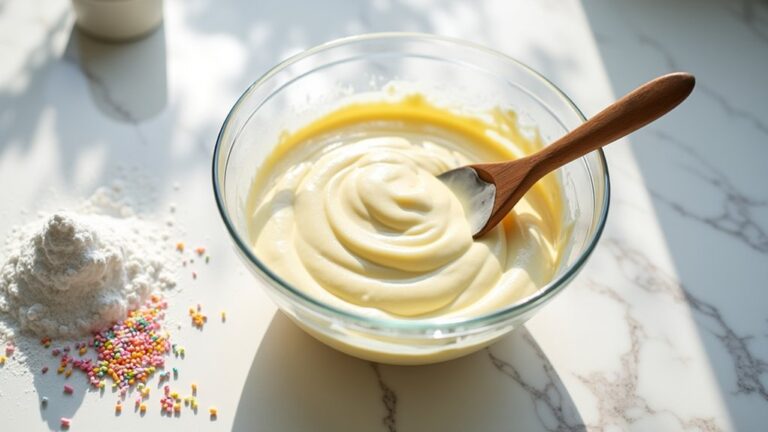Naan Bread Recipe
To make delicious naan bread, mix 2 cups of flour with yeast, sugar, and yogurt to form a smooth dough. Knead it until elastic, let it rest until doubled, then shape into balls. Preheat your tandoor or skillet for cooking, ensuring it’s hot enough for that perfect puff. Brush with melted butter or garlic for extra flavor. With these basics, you’ve got a great start, and there’s so much more to explore about naan’s rich culinary journey.
Contents
History
Naan bread, with its soft texture and delightful flavor, has a rich history that traces back centuries. You’ll discover that naan origins are deeply rooted in the Indian subcontinent, where it’s been a staple for generations. Traditionally baked in clay ovens called tandoors, this versatile bread not only accompanies meals but also symbolizes hospitality and cultural bonding. You can feel its cultural significance echoing through the ages, as families gather around shared dishes, breaking bread together. Naan has traveled far beyond its homeland, adapting to various cuisines and becoming a beloved delicacy worldwide. Each bite connects you to a vibrant tapestry of history, tradition, and the enduring spirit of togetherness that transcends borders.
Recipe
Naan bread is a traditional Indian flatbread that is soft, pillowy, and perfect for scooping up curries or enjoying on its own. This versatile bread is typically cooked in a tandoor oven, but you can easily replicate the technique at home using a skillet or oven. With just a few ingredients, you can create a delicious naan that will impress your family and friends.
Making naan bread from scratch is a rewarding experience that fills your kitchen with the aroma of freshly baked bread. The dough, which consists of flour, yogurt, yeast, and a touch of sugar, is kneaded until smooth and allowed to rise, giving it that characteristic fluffy texture. Once cooked, you can brush your naan with melted butter or garlic for an extra burst of flavor.
Crafting naan from scratch fills your kitchen with the delightful aroma of fresh bread, creating a fluffy, flavorful experience.
Ingredients:
- 2 cups all-purpose flour
- 1/2 teaspoon sugar
- 1 teaspoon active dry yeast
- 1/2 teaspoon salt
- 1/2 cup plain yogurt
- 1/4 cup warm water
- 2 tablespoons melted butter or ghee (for brushing)
- Optional: minced garlic or chopped cilantro for garnish
To make naan, start by combining the warm water, sugar, and yeast in a small bowl. Let it sit for about 5-10 minutes until frothy. In a large mixing bowl, combine the flour and salt. Once the yeast mixture is ready, add it along with the yogurt to the flour mixture. Knead the dough until it is smooth and elastic, about 8-10 minutes. Cover the bowl with a damp cloth and let it rise in a warm place for about an hour or until doubled in size. After rising, divide the dough into small balls and roll each one out into a teardrop or oval shape. Heat a skillet over medium-high heat and cook each naan for about 1-2 minutes on each side, or until golden brown. Brush with melted butter or ghee before serving.
For the best results, make certain your skillet is hot enough before adding the naan; this guarantees a nice char and fluffy texture. If you want to experiment with flavors, consider adding herbs or spices to the dough, such as cumin or coriander. Additionally, you can store any leftover naan in an airtight container or freeze it for future use. When reheating, a quick toast in the skillet will bring back its original softness. Enjoy your homemade naan with your favorite dishes!
Cooking Steps
Now that you’ve got your ingredients ready, it’s time to bring your naan to life with some simple cooking steps. Start by mixing the flour and water until it forms a smooth dough, then knead it thoroughly for that perfect texture. After letting it rest covered, you’re just a few steps away from shaping it into balls and preheating your tandoor oven for that authentic finish.
Step 1. Mix Flour and Water
As you begin creating the perfect naan, mixing flour and water is the essential first step that sets the foundation for your dough. Choose the right flour types, like all-purpose or whole wheat, to achieve the texture you desire. In a large bowl, combine your flour with a pinch of salt to enhance the flavor. Next, slowly add warm water—ideally around 110°F—to activate the yeast if you’re using it. This temperature helps the dough rise beautifully. As you pour the water, use a wooden spoon or your hands to bring the mixture together. You’re aiming for a soft, pliable dough that’s not too sticky. Enjoy the process and embrace the freedom of creating your own perfect naan!
Step 2. Knead the Dough Thoroughly
Kneading the dough transforms your mixture into a smooth, elastic texture essential for great naan. Start by dusting your work surface with flour and place your dough on it. Using the palms of your hands, push the dough away from you, then fold it back over itself. This motion enhances dough elasticity, creating a pliable, airy base. Repeat this process for about 8-10 minutes, adjusting the flour as needed to prevent sticking. Don’t rush; the longer you knead, the better your naan will be. Try different kneading techniques, like the French fold or a simple slap-and-fold, to find what feels right to you. Enjoy the freedom of creating your perfect naan dough!
Step 3. Rest the Dough Covered
After thoroughly kneading your dough, it’s time to let it rest. This resting period is essential for achieving that perfect naan texture. By covering the dough, you prevent moisture loss, which enhances dough hydration and allows the gluten to relax. Find a warm, cozy spot in your kitchen, as this encourages fermentation, resulting in a lighter, fluffier bread. Let the dough sit for at least an hour, but if you have time, longer is even better. You’ll notice the dough doubling in size, a sign that it’s ready for the next step. Embrace this moment; it’s a chance for the flavors to develop, setting you up for a delicious naan that you’ll love to share.
Step 4. Shape the Dough Into Balls
Once your dough has rested and doubled in size, it’s time to transform it into individual pieces. Begin by lightly flouring your work surface to prevent sticking. Gently punch down the dough to release any air bubbles, observing its smooth, elastic dough texture. Divide the dough into equal sections, aiming for a ball size that suits your preference—typically, about the size of a golf ball works well. Roll each piece between your palms, using a gentle motion to achieve a round shape. Don’t worry if they aren’t perfect; each ball will have its own character. Once you’ve shaped your dough into balls, let them rest briefly, allowing the gluten to relax, making your naan even more delightful to cook.
Step 5. Preheat the Tandoor Oven
Before you start cooking your naan, preheating the tandoor oven is vital for achieving that signature char and flavor. Set your tandoor to reach a high temperature, ideally around 500°F (260°C), to guarantee your naan cooks evenly and quickly. This intense heat is essential for developing those delightful bubbles that make naan so irresistible. While the oven heats, familiarize yourself with some baking techniques—placing the dough on the tandoor’s walls allows it to puff up beautifully. As you wait, take a moment to enjoy the anticipation of that warm, aromatic bread. Make certain the tandoor isn’t just hot, but roaring, to capture the essence of traditional naan. Once ready, you’re set for an unforgettable cooking experience!
Nutritional Guide
While you enjoy the warm, pillowy goodness of naan bread, it’s also important to contemplate its nutritional profile. Naan can be a delightful addition to your meals, offering various nutritional benefits. However, you should be mindful of dietary considerations like portion sizes and ingredients.
Here’s a quick look at the nutritional aspects:
| Nutrient | Amount per Serving |
|---|---|
| Calories | 200 |
| Carbohydrates | 34g |
| Protein | 6g |
Balancing naan with protein and veggies can enhance its overall health impact. Opt for whole wheat versions if you’re seeking more fiber, and remember, moderation is key to enjoying this delicious bread while staying mindful of your health goals.
Final Thoughts
As you savor the deliciousness of naan bread, it’s essential to reflect on how it fits into your overall culinary experience. This versatile flatbread not only complements a range of dishes but also carries deep cultural significance, connecting you to the rich traditions of South Asian cuisine. Imagine pairing it with flavorful curries, grilled meats, or even as a base for a vibrant sandwich. The serving suggestions are endless—try it with garlic and herbs or topped with cheese for a delightful twist. Ultimately, making naan at home empowers you to embrace that freedom in the kitchen, allowing you to customize flavors to your liking. Celebrate this beloved bread and its ability to bring people together, enriching your meals with each bite.
Frequently Asked Questions
Can Naan Bread Be Made Gluten-Free?
Yes, you can definitely make gluten-free naan! Experiment with gluten-free alternatives like almond flour or chickpea flour. Enjoy delicious naan bread variations that cater to your dietary needs while still satisfying your taste buds.
How Can I Store Leftover Naan Bread?
To keep naan freshness, wrap it in foil or parchment paper, then store it in an airtight container. You can also freeze it for longer storage. Just reheat before enjoying that delightful taste again!
What Are Common Toppings for Naan Bread?
When it comes to topping variations, you’ve got a world of flavors at your fingertips. Traditional toppings like garlic, butter, or cilantro elevate naan’s appeal, while creative options like cheese or herbs spark culinary freedom. Enjoy!
Can Naan Bread Be Frozen?
Yes, you can freeze naan bread! Use proper freezing techniques like wrapping it tightly in plastic wrap and then aluminum foil. This way, you’ll enjoy delicious, warm naan anytime you crave it, without hassle.
Is Naan Bread Vegan-Friendly?
Imagine tearing into a warm, fluffy naan. You wonder, is it vegan-friendly? Luckily, many recipes swap traditional ingredients for vegan substitutes, making it a delightful choice for plant-based eaters. Enjoy freedom in every bite!
Conclusion
So there you have it—naan bread, the culinary superstar that’s probably more popular than your last social media post! With its pillowy softness and ability to scoop up curry like a champ, it’s basically the MVP of your dinner table. Who knew a flatbread could be so versatile? Now, roll up those sleeves, release your inner chef, and impress your friends. Just remember, if they ask for store-bought, you might need to reconsider your friendship choices!
